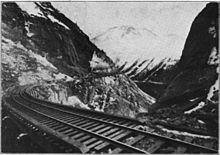White Pass and Yukon Route
The narrow gauge also permitted tighter radii to be used on curves, making the task easier by allowing the railroad to follow the landscape more, rather than having to be blasted through it.
Construction started in May 1898, but they encountered obstacles in dealing with the Skagway city government and the town's crime boss, Soapy Smith.
The company president, Samuel H. Graves (1852–1911), was elected as chairman of the vigilante organization that was trying to expel Soapy and his gang of confidence men and rogues.
The construction crews working from Bennett along a difficult lakeshore reached Carcross the next year, and the last spike was driven on July 29, 1900, with service starting on August 1, 1900.
Financing and route was in place to extend the rails from Whitehorse to Carmacks, but there was chaos in the river transportation service, resulting in a bottleneck.
The White Pass instead used the money to purchase most of the riverboats, providing a steady and reliable transportation system between Whitehorse and Dawson City.
It carried passengers and freight between the SS Tutshi operating on Tagish Lake and the MV Tarahne[30] operating across Atlin Lake to Atlin, British Columbia (While Tutshi was destroyed by a suspicious fire around 1990, Tarahne was restored and hosts special dinners including murder mysteries.
Following the Attack on Pearl Harbor, the decision was made by the US and Canadian governments to construct the Alaska Highway as an all-weather overland route to ensure communication.
Even this was deemed insufficient, so the U.S. Government leased the railroad for the duration, effective at 12:01 a.m. on 1 October 1942, handing control to the United States Army.
Major John E. Ausland, a former executive with the Chicago, Burlington and Quincy Railroad, was named superintendent, while Lieutenant Stanley Jerome Gaetz was trainmaster.
[32] Canadian law forbade foreign government agencies from operating within Canada and its territories, but Japanese forces had occupied some of the Aleutian Islands by this time, and an accommodation was quickly reached to "make an illegal action legal."
The MRS scoured the US for usable narrow-gauge locomotives and rolling stock, and soon a strange and colorful assortment began arriving at Skagway.
The railroad was an early pioneer of intermodal freight traffic, commonly called containerization; advertising of the time referred to it as the Container Route.
This enormous investment made the company dependent on continued ore traffic to earn the revenue, and left the railway vulnerable to loss of that ore-carrying business.
In 1982, metal prices plunged, striking with devastating effect on the mines that were the White Pass and Yukon Route's main customers.
The five diesels sold to Colombia were not used there as they were too heavy, and were re-acquired in 1999; one was nearly lost at sea during a storm as it broke loose on the barge and slowly rolled towards the edge.
Cruise operators, remembering the attraction of the little mountain climbing trains to their passengers, pushed for a re-opening of the line as a heritage railway.
The White Pass Route also bid on the ore-haul from the newly reopened Faro mine, but its price was considerably higher than road haulage over the Klondike Highway.
Most of the tracks in downtown Whitehorse have now been torn up, and the line's terminus is six city blocks south of the old train depot at First Avenue and Main Street.
After customs and Canadian Labour Union jurisdictional issues were resolved, the WP&YR main line reopened to Fraser in 1989, and to Bennett in 1992.
WP&YR acquired some rolling stock from Canadian National's Newfoundland operations, which shut down in November 1988; the acquisition included 8 side-pivot, drop-side air dump cars for large rocks, and 8 longitudinal hoppers for ballast, still painted in CN orange.
Also operational, a few times a year, is an original steam-powered rotary snowplow, an essential device in the line's commercial service days.
When participants seemed unlikely to reach the planned numbers, surplus seats were sold to the public (120 USD or 156 CAD), with bus return to Carcross from Fraser.
White Pass president Gary Danielsen advised a CBC Radio interviewer that service to Whitehorse would require an enormous capital investment to restore the tracks, but the company is willing if there is either a passenger or freight potential to make it cost-effective.
A June 2006 report on connecting Alaska to the continental railroad network suggested Carmacks as a hub, with a branch line to Whitehorse and beyond to either Skagway or Haines, Alaska.Several former White Pass steam locomotives are currently in operation at tourist attractions in the Southeastern United States.
The operator's mistake caused the pipeline to rupture and spill between 1,000 and 5,000 US gallons (830 and 4,160 imp gal; 3,800 and 18,900 L) of heating oil into the Skagway River.
After remand by the 9th Circuit Court of Appeals, the President settled on a plea agreement on misdemeanor charges of making negligent misrepresentations to the Coast Guard.
There are two persistent myths regarding the role the White Pass & Yukon Route played in building the Alaska Highway during the Second World War.
They concern the eleven new USATC S118 Class locomotives that the United States Army Transportation Corps brought to the WP&YR in 1943.
The initial 1942 sale order to Baldwin was for 60 MacArthur 1,000 mm (3 ft 3+3⁄8 in) gauge locomotives for India's extensive meter-gauge rail network.













